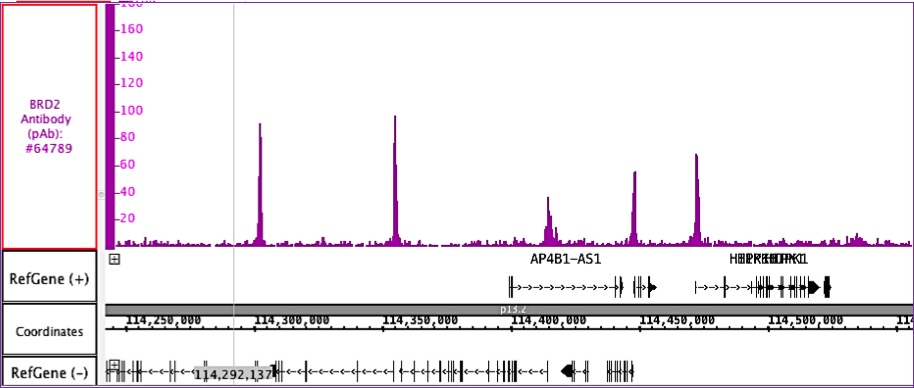BRD2 antibody (pAb)
Host / Isotype
Rabbit / IgG
Reactivity
Human
Applications
ChIP, ChIP-Seq
Cat No : 61797,61798 61797
Synonyms
Validation Data Gallery
Product Information
| Tested Applications |
ChIP, ChIP-Seq
Applications Validated by Active Motif: ChIP-Seq: 6 ul per ChIP |
| Tested Reactivity | Human |
| Host / Isotype | Rabbit / IgG |
| Class | Polyclonal |
| Type | Antibody |
| Immunogen | This BRD2 antibody was raised against a recombinant protein comprising amino acids 58-232 of human BRD2 (NP_005095 ). |
| Full Name | BRD2 antibody (pAb) |
| Synonyms | Bromodomain, BRD3, BRD4, BRD, chromodomain, Tudor domain, chromatin, histone, polyclonal antibody, chip, chip-seq, epigenetics |
| Molecular weight | 110 kDa |
| GenBank accession number | NP_005095 |
| RRID | AB_2793770 |
| Purification Method | Affinity Purified |
| Buffer | Purified IgG in PBS with 30% glycerol and 0.035% sodium azide. Sodium azide is highly toxic. |
| Storage | Some products may be shipped at room temperature. This will not affect their stability or performance. Avoid repeated freeze/thaw cycles by aliquoting items into single-use fractions for storage at -20°C for up to 2 years. Keep all reagents on ice when not in storage. |
Background Information
BRD2 (Bromodomain-containing protein 2) belongs to the BET subclass of proteins, which are characterized by two N-terminal bromodomains and one ET (Extra Terminal) domain. BRDs associate with chromatin through their bromodomains that recognize acetylated histone lysine residues. Bromodomains function as ‘readers’ of these epigenetic histone marks and regulate chromatin structure and gene expression by linking associated proteins to the acetylated nucleosomal targets. The ET domain functions as a protein binding motif and exerts atypical serine-kinase activity. The BET family consists of at least four members in mouse and human, BRD2 (also referred to as FSRG1, RING3), BRD3 (FSRG2, ORFX), BRD4 (FSRG4, MCAP/HUNK1), and BRDT (FSRG3, BRD6). BRD proteins are related to the female Sterile Homeotic protein in Drosophila, a gene required maternally for proper expression of other homeotic genes, such as Ubx, which is involved in pattern formation. BRD2 causes elevated protein kinase activity in leukemias. Transgenic mice overexpressing BRD2 in the lymphoid system develop diffuse large-cell lymphoma. BRD2 has been shown to interact with E2F1 and with histone H4 acetylated at Lys12 via its two bromodomains. BRD2 may play a role in spermatogenesis or folliculogenesis. Genetic evidence links the BRD2 gene to both juvenile myoclonic epilepsy and photoparoxysomal responses.

